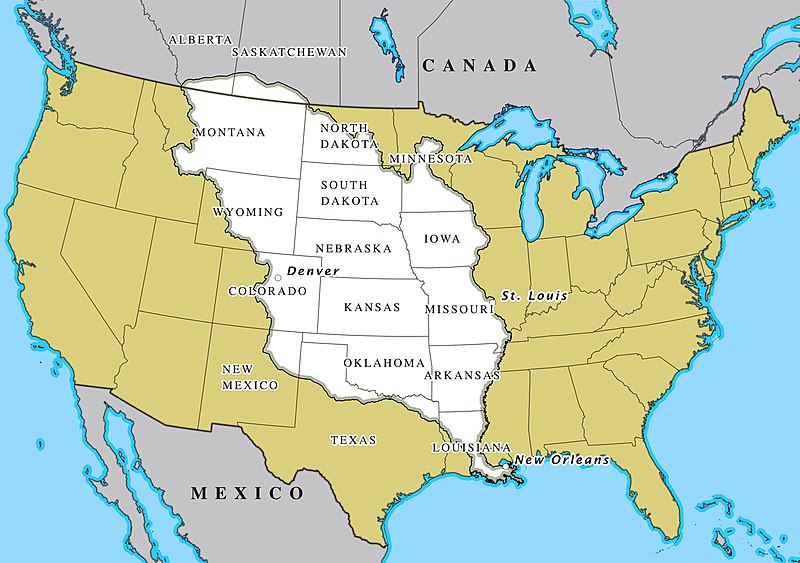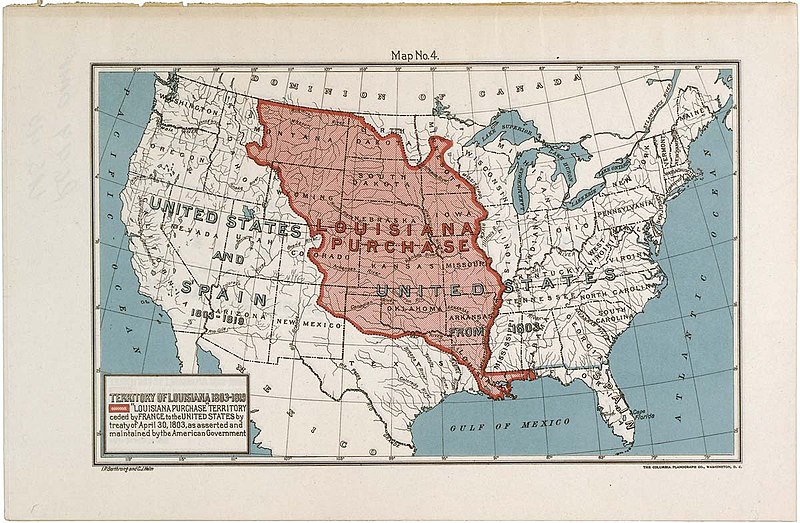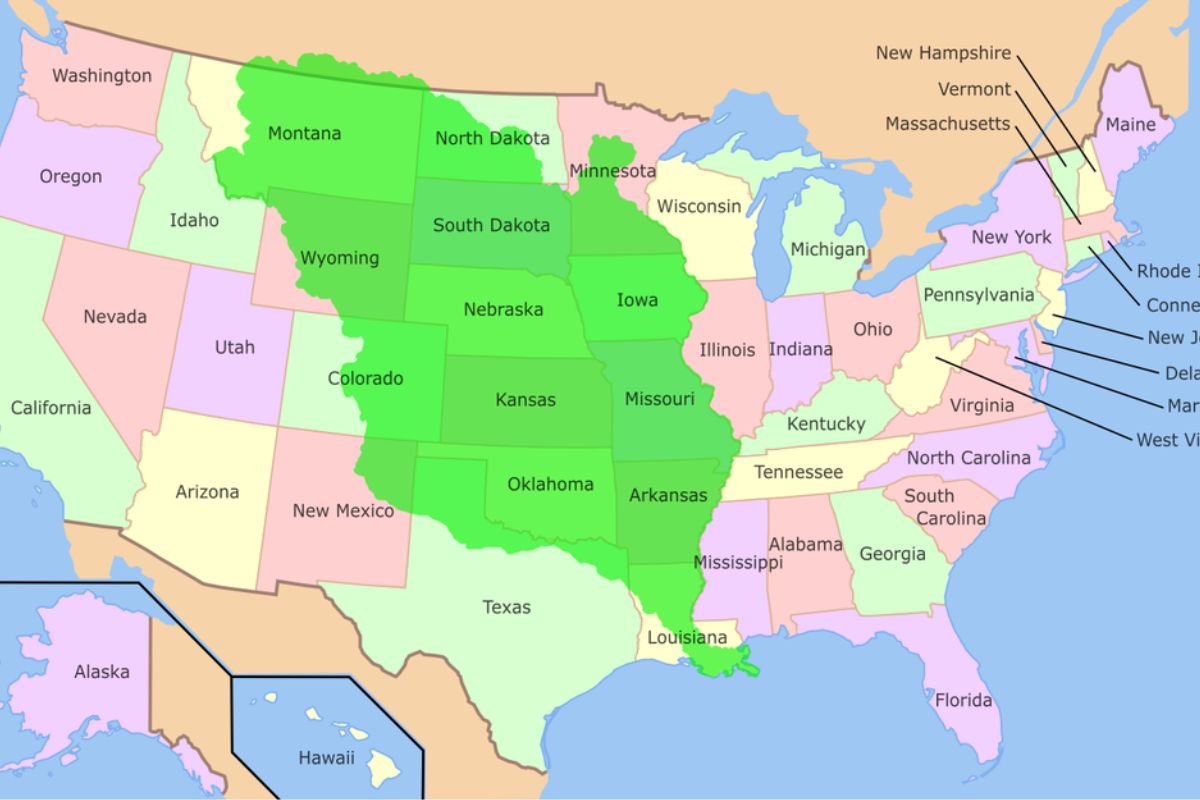The Louisiana Purchase was one of the largest land deals in history. In 1803, the United States paid approximately $15 million to France for more than 800,000 square miles of land. This land deal was a monumental event in the history of both countries.
The Louisiana territory stretched from the Mississippi River to the Rocky Mountains and from the Gulf of Mexico to the Canadian border. Thirteen states were carved from the Louisiana Territory. The Louisiana Purchase nearly doubled the size of the United States, significantly strengthened the country economically, politically, and strategically, and paved the way for westward expansion.
France, under the leadership of Napoleon Bonaparte, sold the territory to the U.S. due to financial and military considerations. The deal was brokered for the U.S. by Robert R. Livingston and James Monroe, who exceeded their mandate of purchasing New Orleans and its vicinity, and instead secured one of the most influential and important land deals in history.
President Thomas Jefferson was initially concerned that the U.S. Constitution did not include provisions for acquiring territory by treaty. Still, he eventually made the pragmatic decision to complete the purchase to secure the much-needed territory, remove the foreign presence on the nation’s borders, and provide for future growth.
The Louisiana Purchase marked an important moment in the presidency of Thomas Jefferson. At the same time, it signaled the start of great expansion westward, and, unfortunately, it also spurred heated debate over the expansion of slavery into new American territories, foreshadowing conflicts to come.
| Year | Event |
|---|---|
| 1682 | Robert de La Salle claims Mississippi River Basin for France. |
| 1718 | New Orleans is founded. |
| 1762-1763 | France cedes Louisiana to Spain. |
| 1800 | Spain returns Louisiana to France. |
| 1801 | U.S. begins negotiations to buy land near the Mississippi River. |
| April, 1803 | U.S. offered to buy entire Louisiana territory. |
| April 30, 1803 | Louisiana Purchase agreement is signed. |
| July 4, 1803 | Louisiana Purchase is announced in U.S. |
| October 20, 1803 | U.S. Senate ratifies treaty. |
| December 20, 1803 | U.S. takes possession of Louisiana. |
| March 10, 1804 | Formal transfer of territory to U.S. in St. Louis. |
| 1804-1806 | Lewis and Clark expedition. |
| 1812 | Louisiana becomes the 18th state of the Union. |
Timeline of the Louisiana Purchase
1682 – Robert de La Salle claims Mississippi River Basin for France
Robert de La Salle was a French explorer who descended the Mississippi River, reaching the river’s mouth in the Gulf of Mexico in 1682.
He claimed the entire Mississippi River basin for France, calling it “Louisiana” after King Louis XIV, who was the reigning monarch at the time.
This included a large part of what is now the central United States, stretching from the Great Lakes to the Gulf of Mexico and from the Appalachians to the Rocky Mountains.

1718 – New Orleans is founded
Jean-Baptiste Le Moyne de Bienville, a French colonial administrator in Louisiana, founded the city of New Orleans in 1718. He named it in honor of the then Regent of France, Philippe II, Duke of Orléans.
The city’s strategic location near the mouth of the Mississippi River made it a vital asset in the control of the vast Louisiana territory, and it became a major center for trade and culture.
1762-1763 – France cedes Louisiana to Spain
After their defeat in the Seven Years’ War, France ceded its territories west of the Mississippi River to Spain in the Treaty of Fontainebleau (1762).
The transfer of Louisiana from France to Spain was ratified in the Treaty of Paris (1763), which ended the Seven Years’ War. Under Spanish control, Louisiana would see further economic development, especially in New Orleans.
This period of Spanish rule lasted until 1800 when, through the secret Treaty of San Ildefonso, Spain returned the Louisiana territory back to France.
1800 – Spain returns Louisiana to France
After nearly four decades of Spanish control, the Louisiana Territory was returned to France in 1800.
This transfer was a result of the secret Treaty of San Ildefonso, where Spain, under pressure from Napoleon Bonaparte, agreed to return the territory. However, news of this transfer did not reach the United States until 1801.
This caused considerable concern in the U.S., especially for President Thomas Jefferson, as France was seen as a more formidable colonizer and competitor for control of North America.
1801 – U.S. begins negotiations to buy land near the Mississippi River
As a response to the threat of a powerful France on the western frontier and the potential restriction of U.S. access to the vital New Orleans port and the Mississippi River, President Jefferson initiated negotiations to buy land near the Mississippi River and New Orleans from France. Jefferson sent James Monroe and Robert R. Livingston to France to negotiate the purchase.
1803, April – U.S. offered to buy entire Louisiana territory
Jefferson’s envoys in Paris, James Monroe and Robert R. Livingston, were surprised when the French Foreign Minister Talleyrand offered them not just the city of New Orleans, but the entire Louisiana Territory.
This was because France was dealing with financial difficulties and military challenges in Europe, especially the renewed conflict with the United Kingdom. Napoleon Bonaparte, then leader of France, decided it would be more beneficial to sell the territory and use the funds to finance his military campaigns in Europe.
The U.S. agreed to the offer, seeing it as a way to avoid conflict with France, secure American trade routes, and provide room for the country’s westward expansion.

1803, April 30 – Louisiana Purchase agreement is signed
James Monroe and Robert R. Livingston, representing the United States, and François Barbé-Marbois, the French Treasury Minister, signed the Louisiana Purchase Treaty in Paris.
The United States agreed to pay 60 million francs ($15 million) for the territory, which included an immediate payment of 20 million francs and the assumption of French debts to American citizens worth approximately 40 million francs.
The purchase doubled the size of the United States, adding an area that included land from fifteen present U.S. states and two Canadian provinces.
1803, July 4 – Louisiana Purchase is announced in the U.S.
The United States officially announced the Louisiana Purchase on Independence Day. The news was met with much public excitement and support, especially from those advocating for westward expansion.
However, some Federalists were wary of the constitutionality of the acquisition and feared that the addition of so much western territory would dilute the political power of the eastern states.
1803, October 20 – U.S. Senate ratifies the treaty
After much debate, the U.S. Senate ratified the Louisiana Purchase Treaty by a vote of 24 to 7. The size of the United States doubled with this acquisition, and the nation gained control of the Mississippi River and the port of New Orleans, thus securing crucial trade routes.
Furthermore, the purchase demonstrated the U.S. intent to expand westward, setting a precedent for future territorial acquisitions.
The constitutionality of the purchase was questioned by some, as the Constitution did not explicitly state that the federal government could acquire new territory, but the significance of the acquisition overrode these concerns.
1803, December 20 – U.S. takes possession of Louisiana
In a ceremony known as the “Three Flags Day”, the United States formally took possession of the Louisiana Territory from France in St. Louis. The ceremony began with the lowering of the Spanish flag, which had remained flying over the city during France’s theoretical ownership.
The French Tricolor was then raised, and finally the American flag was hoisted, signifying the official transfer of the territory to the United States.
1804, March 10 – Formal transfer of territory to U.S. in St. Louis
A formal ceremony was held to signify the transfer of the Louisiana Territory from France to the United States. This was the final step in the physical transaction of the territory and was a major turning point in the expansion of the United States.
The newly acquired territory was initially organized into the Territory of Orleans (which roughly corresponded to the present-day state of Louisiana) and the District of Louisiana (which covered the rest of the Purchase).
1804-1806 – Lewis and Clark expedition
President Jefferson commissioned an expedition to explore the newly acquired western territory soon after the purchase was finalized.
The expedition, led by Meriwether Lewis and William Clark, aimed to study the area’s plants, animal life, and geography and to learn how the region could be exploited economically.
The expedition also aimed to establish trade with, and assert U.S. sovereignty over, the Native American tribes along the Missouri River.
Helping to strengthen the U.S. claim to the Oregon territory, the expedition provided valuable information about the geography, indigenous tribes, and animal and plant life of the Western portion of the continent.
1812 – Louisiana becomes the 18th state of the Union
After several years as a U.S. territory, Louisiana applied for statehood. There were several issues to address first, including determining the borders of the new state, drafting a state constitution, and resolving issues related to the legal system and language, as much of the territory’s population were French-speaking.
Eventually, these issues were resolved, and on April 30, 1812, Louisiana was admitted to the Union as the 18th state. The Louisiana statehood marked the start of the legal and political incorporation of the Louisiana Purchase territories into the Union, a process that would continue throughout the 19th century.
